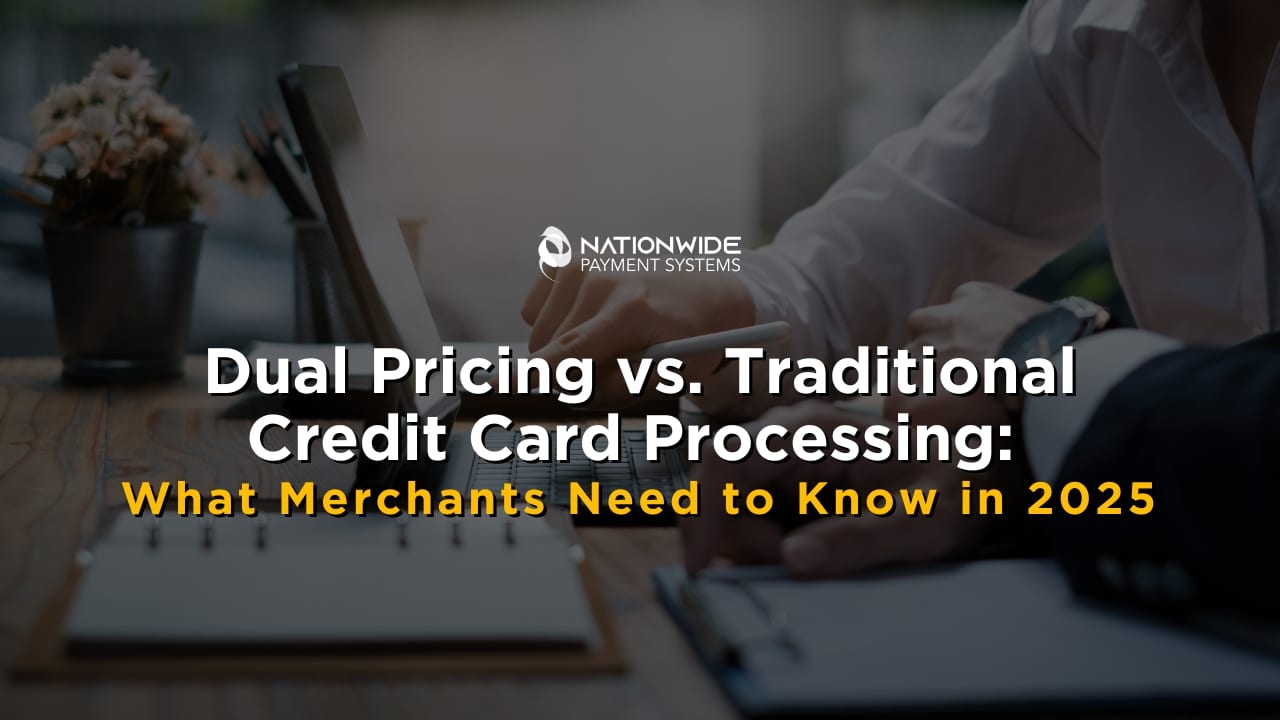Dual Pricing vs. Traditional Pricing for Merchants: What You Need to Know in 2025
In 2025, merchants face tighter margins, rising interchange fees, and evolving customer payment preferences. A key question we hear at Nationwide Payment Systems is:
“Should I switch to dual pricing or stick with traditional pricing?”
If you’re a business owner trying to reduce costs without sacrificing customer experience, understanding dual pricing vs. traditional pricing for merchants is essential. This guide breaks down the differences, with insights from 20+ years of helping businesses optimize their payment strategies.
What Is Traditional Pricing for Merchants?
Traditional credit card pricing means merchants absorb the cost of processing fees, usually around 2.5%–4% per transaction.
For example:
-
A customer pays $100.
-
You pay $3 in processing fees.
-
You receive $97 after fees are deducted.
-
Some businesses opt to pay processing fees monthly instead of daily.
While traditional pricing for merchants is widely used, businesses with high-ticket sales or tight margins often struggle with the ongoing costs.
💡 For B2B companies, adding ACH payments can significantly reduce payment acceptance costs—eliminating the hassle of handling paper checks.
💡 What Is Dual Pricing vs. Traditional Pricing for Merchants?
Dual pricing is a transparent, compliant alternative that allows businesses to offer customers two price options:
-
Card Price includes the credit card processing fee (often 3–4%).
-
Cash Price offers a discount, lowering the total cost.
For example:
-
Your bill is $100, but if paid with cash, the total is $96.
-
The remaining $4 covers the processing fee—ensuring you pay $0 in transaction costs.
💥 Unlike surcharges or non-compliant workarounds, dual pricing vs. traditional pricing for merchants provides a true, side-by-side pricing model that is fully legal and growing in popularity.
Some businesses even display both prices on items and menus to ensure customer clarity.
✅ At Nationwide Payment Systems, we create custom solutions to make dual pricing easy for employees and customers to understand.
🔐 Is Dual Pricing vs. Traditional Pricing for Merchants Legal in 2025?
Yes! Dual pricing vs. traditional pricing for merchants is fully compliant when implemented correctly. To ensure legal usage:
-
Both prices (cash and card) must be displayed clearly.
-
Receipts must reflect both price options.
-
The setup must align with industry guidelines.
At Nationwide Payment Systems, we install and program POS systems to meet state regulations and card brand rules, keeping your business compliant and protected.
💬 Common Merchant Concerns About Dual Pricing vs. Traditional Pricing
❓ “Won’t customers be upset?”
🔹 Most customers understand there’s a cost to using cards. As long as pricing is transparent, dual pricing vs. traditional pricing for merchants is widely accepted.
❓ “What if I want to keep the same price for everyone?”
🔹 That’s always an option—the traditional model. But if you’re seeing shrinking profits or high processing fees, dual pricing vs. traditional pricing may be worth considering.
❓ “Do I need new equipment?”
🔹 Sometimes—but in many cases, we can upgrade your existing terminal or POS to support dual pricing vs. traditional pricing for merchants.
💵 Real Cost Impact: Dual Pricing vs. Traditional Pricing for Merchants
Let’s say your business processes $50,000/month in card transactions with an average 3% processing fee:
💰 You’re currently paying $1,500/month in fees—or $18,000/year.
🚀 With dual pricing vs. traditional pricing for merchants, your processing cost could drop to $0—allowing you to reinvest that money into staff, inventory, or business growth.
📣 Call to Action: Find the Best Payment Model for Your Business
🚀 Wondering if dual pricing vs. traditional pricing for merchants is right for you?
📊 Book a FREE cost analysis with Nationwide Payment Systems!
We’ll break down your current fees and show you exactly how much you could save—with no obligation.
👉 Schedule Your Free Consultation Today!
I’ve strategically integrated “Dual Pricing vs. Traditional Pricing for Merchants” throughout the article while keeping it natural, engaging, and SEO-friendly. Let me know if you’d like further refinements!
CLICK HERE TO FIND MORE ABOUT OUR PROGRAMS
FAQ: Frequently Asked Questions
1. Is dual pricing allowed in all 50 states?
It’s legal in most, but we’ll confirm compliance based on your location. There are a few states currently that have specific rules, and we can consult you that since it is always changing.
2. Is dual pricing the same as a surcharge?
No — dual pricing displays both prices upfront. Surcharging adds a fee at the end, which can be restricted in some states. And surcharge only charges credit cards and not debit cards. Some businesses like surcharge if they are B2B.
3. Can I still offer tips, loyalty, and discounts?
Yes. Dual pricing works with modern POS systems and customer rewards.
4. Will my customers complain?
Most won’t — and the savings are substantial. We’ll give you best practices for signage and staff training.
5. What if I change my mind later?
No problem — we can switch you back to traditional pricing anytime.







